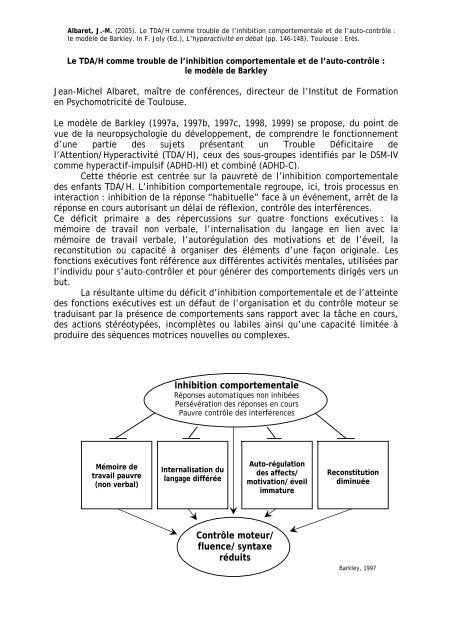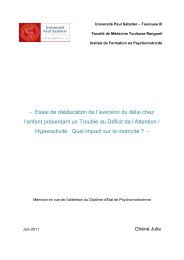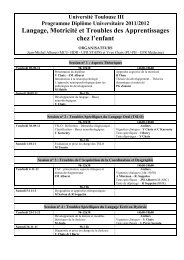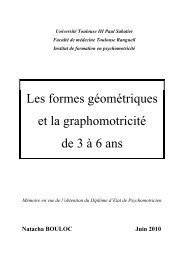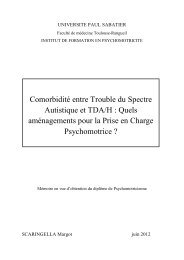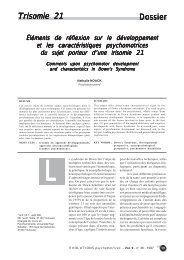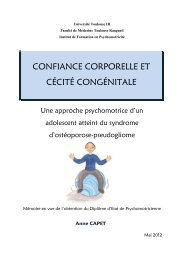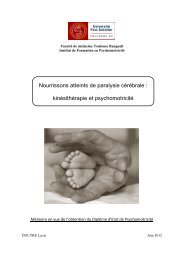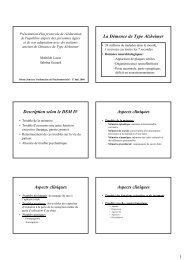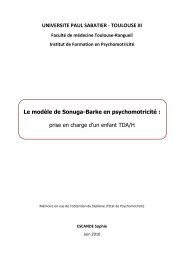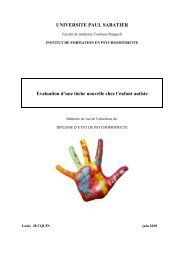le modèle de Barkley - Institut de Formation en Psychomotricité de ...
le modèle de Barkley - Institut de Formation en Psychomotricité de ...
le modèle de Barkley - Institut de Formation en Psychomotricité de ...
You also want an ePaper? Increase the reach of your titles
YUMPU automatically turns print PDFs into web optimized ePapers that Google loves.
Albaret, J.-M. (2005). Le TDA/H comme troub<strong>le</strong> <strong>de</strong> l’inhibition comportem<strong>en</strong>ta<strong>le</strong> et <strong>de</strong> l’auto-contrô<strong>le</strong> :<strong>le</strong> modè<strong>le</strong> <strong>de</strong> Bark<strong>le</strong>y. In F. Joly (Ed.), L’hyperactivité <strong>en</strong> débat (pp. 146-148). Toulouse : Erès.Les différ<strong>en</strong>tes manifestations et <strong>le</strong>s symptômes du TDA/H sont la conséqu<strong>en</strong>ced’un dysfonctionnem<strong>en</strong>t, d’un retard <strong>de</strong> maturation ou d’une atteinte <strong>de</strong> l’un <strong>de</strong>ces modu<strong>le</strong>s. Les difficultés r<strong>en</strong>contrées au niveau <strong>de</strong> la mémoire <strong>de</strong> travail sontl’intrusion d’une information non pertin<strong>en</strong>te qui détournera <strong>le</strong> sujet <strong>de</strong> la tâcheprincipa<strong>le</strong>, ou <strong>le</strong> mainti<strong>en</strong> d’un matériel qui n’est plus pertin<strong>en</strong>t pouvant aboutir àun phénomène <strong>de</strong> persévération. Un défaut <strong>de</strong> l’auto-régulation <strong>de</strong>s motivations et<strong>de</strong> l’éveil aboutit, par exemp<strong>le</strong>, à une dép<strong>en</strong>dance extrême aux r<strong>en</strong>forcem<strong>en</strong>tsexternes par opposition à une motivation interne <strong>de</strong>vant une tâche considéréecomme contraignante. Le déficit d’internalisation du langage ou <strong>de</strong> soliloque aprincipa<strong>le</strong>m<strong>en</strong>t <strong>de</strong>s répercussions sur la planification et la régulation <strong>de</strong>scomportem<strong>en</strong>ts ainsi que sur la résolution <strong>de</strong> problèmes. L’atteinte <strong>de</strong> lareconstitution r<strong>en</strong>voie à un manque <strong>de</strong> créativité et <strong>de</strong> f<strong>le</strong>xibilité <strong>de</strong>vant unproblème nouveau, aussi bi<strong>en</strong> au niveau <strong>de</strong> la motricité que du langage.Ce modè<strong>le</strong>, que Bark<strong>le</strong>y qualifie <strong>de</strong> modè<strong>le</strong> hybri<strong>de</strong> et unifié <strong>de</strong>s fonctionsexécutives, intègre, d’une part, <strong>le</strong>s travaux <strong>de</strong> Bronowski qui mett<strong>en</strong>t l’acc<strong>en</strong>t surdiffér<strong>en</strong>tes propriétés du langage humain (internalisation du langage permettant <strong>le</strong>contrô<strong>le</strong> du comportem<strong>en</strong>t, possibilité <strong>de</strong> séparer la charge émotionnel<strong>le</strong> ducont<strong>en</strong>u du message et création <strong>de</strong> comportem<strong>en</strong>ts nouveaux et comp<strong>le</strong>xes) et,d’autre part, ceux <strong>de</strong> Fuster concernant <strong>le</strong>s fonctions neuropsychologiques ducortex préfrontal. Bark<strong>le</strong>y s’appuie éga<strong>le</strong>m<strong>en</strong>t sur différ<strong>en</strong>ts travaux qui font étatd’anomalies au niveau du cortex préfrontal et <strong>de</strong>s liaisons qu’il <strong>en</strong>treti<strong>en</strong>t avecd’autres régions du cerveau notamm<strong>en</strong>t <strong>le</strong> striatum mais aussi sur <strong>le</strong> rô<strong>le</strong> <strong>de</strong>srécepteurs dopaminergiques.Plus que <strong>le</strong> défaut d’att<strong>en</strong>tion, c’est donc <strong>le</strong> déficit d’inhibition comportem<strong>en</strong>ta<strong>le</strong>qui est considéré, par Bark<strong>le</strong>y, comme l’élém<strong>en</strong>t cardinal du syndrome. Il proposemême d’y substituer un terme comme celui <strong>de</strong> Troub<strong>le</strong> <strong>de</strong> l’InhibitionComportem<strong>en</strong>ta<strong>le</strong>. Il insiste très clairem<strong>en</strong>t sur l’importance d’un <strong>en</strong>vironnem<strong>en</strong>tstructuré ainsi que sur la nécessité d’une approche multimoda<strong>le</strong> <strong>de</strong>s <strong>en</strong>fants TDA/Het <strong>en</strong> fournit <strong>de</strong>s justifications théoriques. Sa position est qu’il convi<strong>en</strong>t d’associerau traitem<strong>en</strong>t médicam<strong>en</strong>teux un travail auprès <strong>de</strong>s par<strong>en</strong>ts et <strong>de</strong>s <strong>en</strong>seignantspour <strong>le</strong>s ai<strong>de</strong>r à fournir <strong>de</strong>s réponses adéquates aux manifestations <strong>de</strong> l’<strong>en</strong>fant. I<strong>le</strong>st <strong>en</strong>fin nécessaire d’appr<strong>en</strong>dre à l’<strong>en</strong>fant certaines stratégies <strong>de</strong>stinées àsurmonter <strong>le</strong> déficit ou à <strong>en</strong> comp<strong>en</strong>ser <strong>le</strong>s effets néfastes. Les différ<strong>en</strong>tesapproches rééducatives, et principa<strong>le</strong>m<strong>en</strong>t psychomotrices, sont <strong>de</strong> notre point <strong>de</strong>vue toutes désignées pour remplir ce rô<strong>le</strong>.Le modè<strong>le</strong> <strong>de</strong> Bark<strong>le</strong>y (1997a) permet la mise <strong>en</strong> perspective d’un grand nombred’étu<strong>de</strong>s antérieures prov<strong>en</strong>ant <strong>de</strong> divers champs sci<strong>en</strong>tifiques et fournit, <strong>de</strong> plus,un nombre important <strong>de</strong> prédictions testab<strong>le</strong>s permettant d’<strong>en</strong> éprouver lapertin<strong>en</strong>ce pour <strong>le</strong>s sujets TDA/H. Nous ne sommes donc pas <strong>en</strong> prés<strong>en</strong>ce d’unevérité révélée mais d’un auth<strong>en</strong>tique modè<strong>le</strong> sci<strong>en</strong>tifique falsifiab<strong>le</strong>.
Albaret, J.-M. (2005). Le TDA/H comme troub<strong>le</strong> <strong>de</strong> l’inhibition comportem<strong>en</strong>ta<strong>le</strong> et <strong>de</strong> l’auto-contrô<strong>le</strong> :<strong>le</strong> modè<strong>le</strong> <strong>de</strong> Bark<strong>le</strong>y. In F. Joly (Ed.), L’hyperactivité <strong>en</strong> débat (pp. 146-148). Toulouse : Erès.Référ<strong>en</strong>ces bibliographiquesBark<strong>le</strong>y, R.A. (1997a). ADHD and the nature of self-control. New York : Guilford.Bark<strong>le</strong>y, R.A. (1997b). Att<strong>en</strong>tion-<strong>de</strong>ficit/hyperactivity disor<strong>de</strong>r, self-regulation, and time:toward a more compreh<strong>en</strong>sive theory. Developm<strong>en</strong>tal and Behavioral Pediatrics, 18, 4,271-279.Bark<strong>le</strong>y, R.A. (1997c). Behavioral inhibition, sustained att<strong>en</strong>tion, and executive functions :constructing a unifying theory of ADHD. Psychological Bul<strong>le</strong>tin, 121, 1, 65-94.Bark<strong>le</strong>y, R.A. (1998). Att<strong>en</strong>tion–<strong>de</strong>ficit hyperactivity disor<strong>de</strong>r. Sci<strong>en</strong>tific American,septembre, 44-49 (trad. fr. Pour la Sci<strong>en</strong>ce).Bark<strong>le</strong>y, R.A. (1999). Response inhibition in att<strong>en</strong>tion-<strong>de</strong>ficit hyperactivity disor<strong>de</strong>r.M<strong>en</strong>tal Retardation and Developm<strong>en</strong>tal Disabilities Research Reviews, 5, 177-184.


